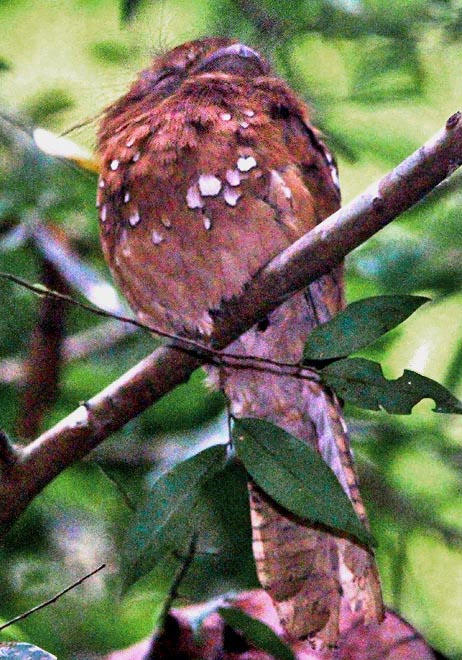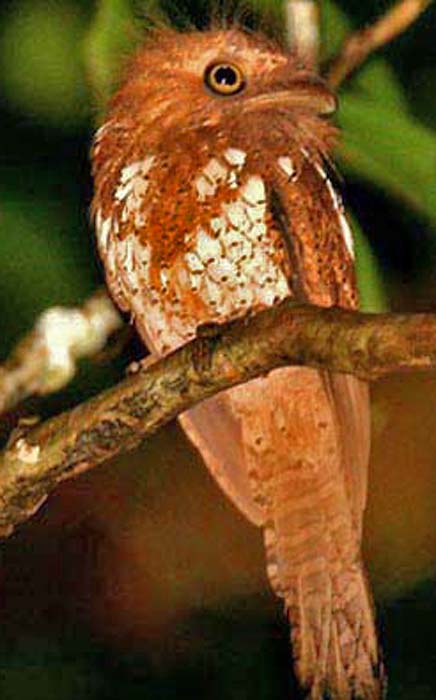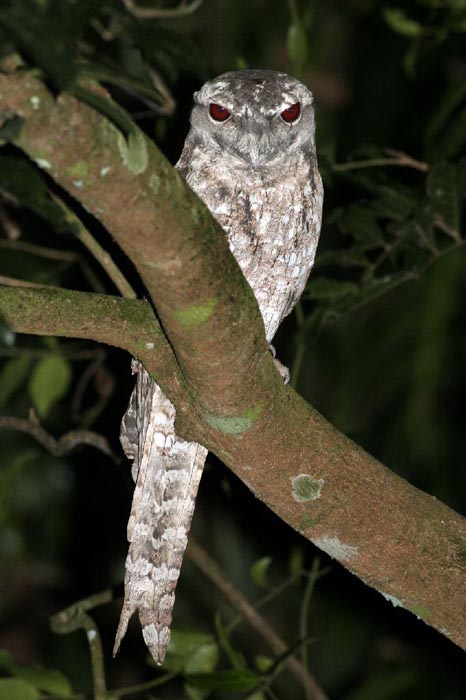
a web page by Don Roberson |
FROGMOUTHS Podargidae |
||
|
||
The first frogmouth that I saw well at night was an Asian Frogmouth — in the beam of a flashlight on Palawan, in the Philippines. It had all sorts of long straggly feathers sticking out the sides of its head, surrounding this huge wide bill. My immediate reaction was to think of Medusa from Greek mythology, a Gorgon female with living venomous snakes in place of hair. It was said that gazing directly into her eyes would turn onlookers into stone. I returned to Palawan years later and this time pointed a camera at a Palawan Frogmouth (left). The eyes of my frogmouth gleamed red in the flash but, fortunately, she did not look directly at me . . . Perhaps you can see from of the unruly head feathers in this shot (a closer photo by Blake Matheson is posted farther down this page). |
||
Some of these bristles and elongated head feathers are also visible on this Blyth's Frogmouth (below left), on its day roost in the Panti forest of Malaysia. At one time Blyth's Frogmouth Batrachostomus affinis and Palawan Frogmouth B. chasni were considered subspecies of Javan Frogmouth B. javensis, but these were split by Cleere (2010) and the split adopted by Clements' world checklist in 2014. Australian Frogmouths are typified by the large and widespread Tawny Frogmouth of Australia (below right in an evocative shot by Murray Lord). This one is well-camouflaged at its day roost, but recalls a giant Wookiee-bird from George Lucas's Star Wars universe. |
||
|
||
| All frogmouths are birds of the night. They are secretive, sit-and-wait understory predators of dense forests. They are vocal in the dark, defending territories with whistles, trills, tremolos, hollow hoots or wheezes. In many species, each sex defends a territory and has distinctive songs or vocalizations. Playback of their voice is an effective way to see a frogmouth at night. This Palawan Frogmouth was called in this way to a perch just above us (below left in an excellent photo © Blake Matheson; this same bird is shown at a greater distance in the first photo on the page, above). Note the unruly Medusa-hair in this species of Asian frogmouth. In contrast, the large and long Papuan Frogmouth, an Australasian frogmouth, looks as dapper as a south Chicago card-shark as its dark eyes pierce the jungles of northeast Queensland, Australia (great photo © Murray Lord). | ||
|
||
 |
||
It is just pure luck to find a frogmouth at a day roost in tropical forests. The late, great Tim Fisher spotted this trio of huddled Philippine Frogmouth (above) at their day-roost on Bohol; we checked the same branch the next day, but they were gone. Years before that, wandering the featureless mallee in Wyperfeld NP, Australia, I came upon this Tawny Frogmouth (below) during the day at a nest. This was a bulky platform of criss-crossed sticks, padded with dry leaves, as is typical of Australasian frogmouths. The nests of Asian frogmouths are quite different, being small, neat, firm cups composed of interwoven down plucked from their own underparts; cobwebs, lichen or leaves are then added to the outside to help conceal it (Holyoak 1999). |
||
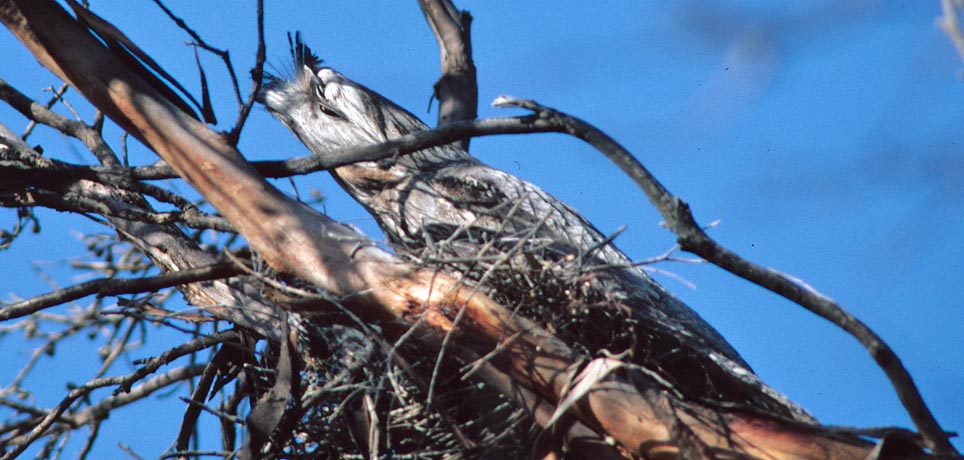 |
||
| The differences in nests, along with the very different body types, have been cited as reasons to split the two groups of frogmouths into separate families. Sibley & Ahlquist (1990) did so formally in their classic tome based on DNA-DNA hybridization studies. More recent molecular studies confirm the division between the two types of frogmouths, and I had split them in some prior versions of this on-line family list. However, the collection in 1998 of a new specimen in the Solomon Islands of a bird, originally described in 1901 as a subspecies of Marbled Frogmouth Podargus ocellatus, changed things. It provided to be highly distinct, having only eight tail feathers instead of the more usual ten or twelve, and in having coarser feathers. It had barred primaries and rectrices, larger speckles and more pronounced white spots. Cleere et al. (2007) moved it to a new genus, Rigidipenna, and it became the Solomons Frogmouth R. inexpectata. In a number of ways it is intermediate between the Asian and Australasian frogmouths, and remains rare, little-known, and elusive. But given this possible 'intermediate' frogmouth, the current trend has been to retain all frogmouths within a single family, pending further research and analysis. | ||
Other than Rigidipenna, the three species of Podargus inhabit Australia and New Guinea. Photos of Tawny and Papuan appear above; the remaining Podargus is Marbled Frogmouth P. ocellatus. As of 2014, there are 11 species of Batrachostomus frogmouths ranging in southern Asia from India and Sri Lanka to the Philippines, Borneo, Sumatra, and Java. Some of the Asian frogmouths have color morphs — gray morph and red morph — recalling the situation in some North American screech-owls. In other Asian species the standard plumage is reddish, without morphs. Frogmouths
are named for their wide bill, sometimes held open in threat display
when disturbed. The smaller Asian frogmouths use the wide bill to
capture beetles, moths, and other insects in flight. Larger frogmouths,
including the Australasian species, consume a variety of prey —
including frogs, lizards, and small mammals (Holyoak 1999). |
||
Photos: The Palawan Frogmouth Batrachostomus chasni
was near Puerta Princessa Subterranean NP on Palawan, Philippines, on
13 Dec 2005; a closer photo by Blake Matheson appears a bit farther
down the page. The roosting Blyth's Frogmouth B. affinis at a known day-roost in the Panti Forest, Malaysia, on 24 Sep 2011. Murray Lord photographed the Tawny Frogmouth Podargus strigoides in the Sydney suburbs, NSW, Australia, on 11 Aug 2009 — from his dining room window! Murray Lord also photographed the Papuan Frogmouth Podargus papuensis at Julatten, Queensland, Australia, on 12 Sep 2008. The trio of roosting Philippine Frogmouth B. septimus were at Rajah Sikatuna Park, Bohol, on 19 Dec 2005. My Tawny Frogmouth on nest was in Wyperfeld NP, Victoria, Australia, on 11 Nov 1983. Bibliographic note: Family Book:
Family Book:
Literature cited:
|
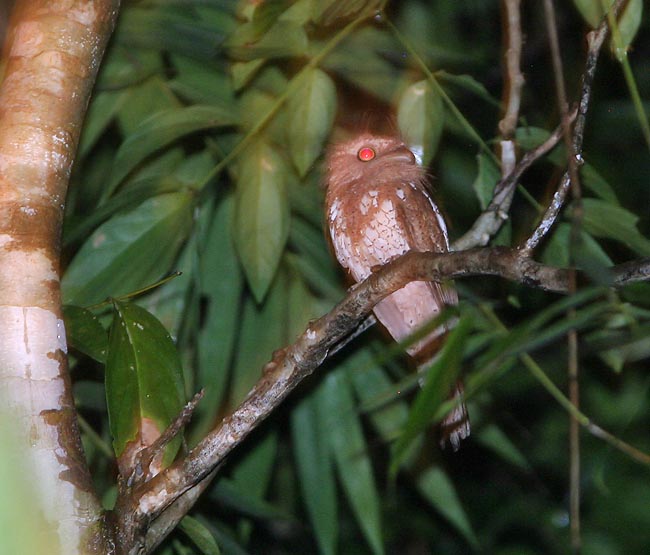 Frogmouths
are among the most weird and wonderful birds on earth. Traditionally,
they are divided into two distinctive subfamilies: Asian Frogmouths
[Batrachostominae] and Australasian Frogmouths [Podarginae]. These are
sometimes proposed as separate families. Both sets are strange and
unworldly nightbirds.
Frogmouths
are among the most weird and wonderful birds on earth. Traditionally,
they are divided into two distinctive subfamilies: Asian Frogmouths
[Batrachostominae] and Australasian Frogmouths [Podarginae]. These are
sometimes proposed as separate families. Both sets are strange and
unworldly nightbirds. 